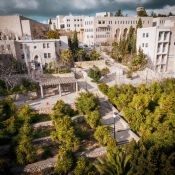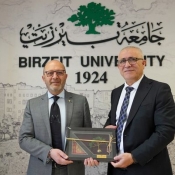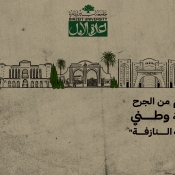Work of Palestinian Artist, Naji Ali, on Display
From Monday 14 September until Thursday 17 September, Birzeit University is host to an exhibition of cartoons by the famous Palestinian artist Naji Ali, who was assassinated in London in 1987. The event is sponsored by students on campus from the Qutub block, and BZU News spoke to Kifah Al-Fani, one of the organizers of the event.
Who was Naji Ali and why is he significant in Palestinian society? Naji Ali was artistically speaking the most important of the exiled Palestinian cartoonists. The whole concept behind Naji’s work was proven with the passage of history in that what he drew came true. Naji was always appreciated because he was very angry, very radical and very honest. According to the famous Palestinian poet, Mahmoud Darwish, Naji spent the last days of his life in Lebanon and London in conflict with everyone and not willing to listen. Naji saw the world divided in two, those who are still fighting and those who betrayed. This view reflected a very clear vision of how he sees the Palestinian situation. Today this view seems very natural. All the cartoons he drew against the Palestinian elite have proven true within the current reality. What we lack as Palestinians today, are people who stand for what they believe in and pay the price for it such as Naji.
Palestine was the focus of his work but at the same time he was a pan-Arabist. Despite his nationalism he was always very careful to give the humanist aspect of being a Palestinian.
In each of his cartoons you will see the image of Handala -a small boy with his back turned, and his hands clasped. Handala is the witness, with his back turned to the public because he is only looking towards PalestineHe will never grow up because he cannot grow up outside of Palestine. In a way he took Handala as a symbol of himself at the time he left Palestine. Handala rarely intervenes or acts but observes what is going on.
What has been the response of students? I think most of the students do not feel any problem in identifying with Naji Ali. He was not a leftist or an Islamist - he’s everybody - the conscience itself. Students are really into it. If you watch the audience they are sinking into the pictures. By the time they reach the end they are really angry about where they are and what is happening. This is an emotional message, which tells people they deserve better. I think people are responding.
How did Naji Ali die? He was threatened in Lebanon and Kuwait and finally assassinated in London in 1987. It is almost certain that he was assassinated by someone acting as a double agent who was both a member of Fatah and a Mossad agent. This makes it very difficult to point to who was responsible, he was threatened by Arafat many times and for this reason he left Beirut to Kuwait and then to London. You can find both Israeli and Palestinian interest in his death. One thing to point out is that after he was shot a Russian health team came to observe his condition and the British hospital did not allow them in. He lived more than two months in a coma and the team was not allowed in.
Why did you decide to do this exhibition? The mental state of Naji Ali has much do with our memory of preceding generations. The living generation has nothing to do physically with his rights, each generation seems to be more detached from their collective memory. Naji Ali was trying to transfer the collective memory into a symbol. It was an image that does not need a complex political theory or terms, it was in black and white. He lived and died using black and white only.
We are doing this event on the occasion of the new students arriving at the university. We are trying to remind people who are now at university and were children during the Intifada about their history. This is very important in trying to create a connection with the collective memory. We want to hold the accumulation of experience, sufferings, knowledge, so people will know who they are and what should be done.






